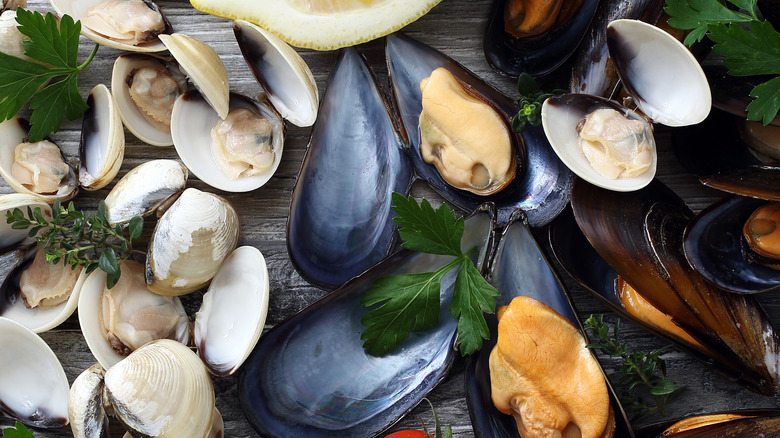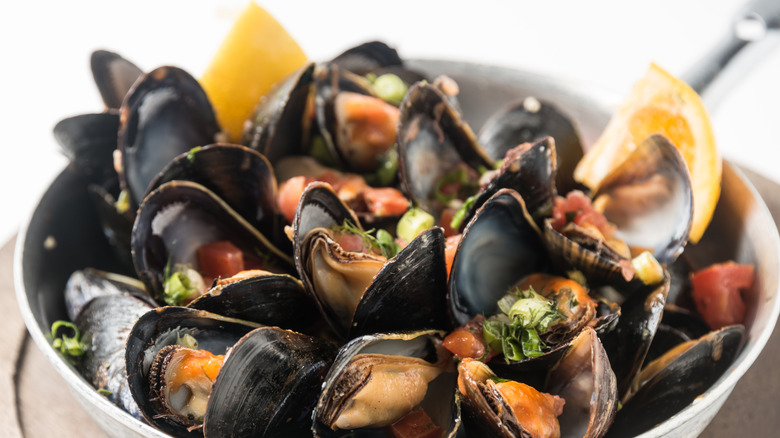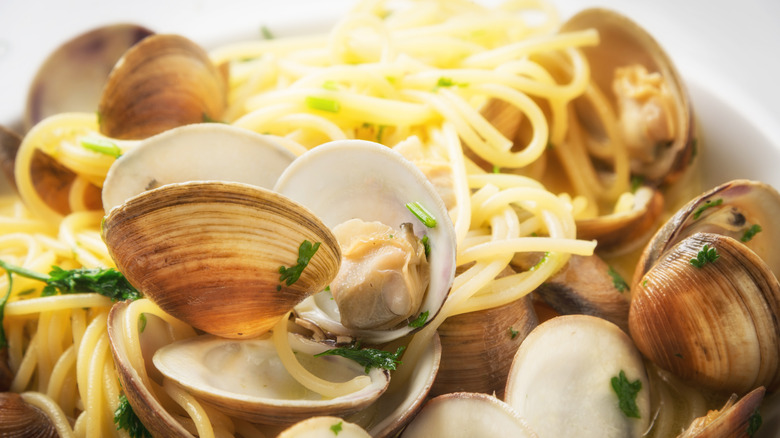Mussels Vs. Clams: What's The Difference?
If you're a fan of seafood, you probably enjoy a steaming pot of mussels or clams on the half shell, especially when you're dining on the waterfront where you can enjoy it fresh. Both shellfish varieties are bivalves, a type of mollusk that have bodies enclosed by a two-hinged shell, just like oysters and scallops. It's easy to get them mixed up if you don't eat seafood often, but when it comes to taste, look, and how the mollusks are served, they're actually quite different.
Both mussels and clams can be found in freshwater and saltwater and both are commonly served steamed in a pot with wine or tomato sauces. But the similarities, including the other ways they're cooked and served, mostly end there. One of the most obvious differences is appearance. Mussels have a dark black, blue, or brown elongated shell whereas clams have a beige, gray, or white rounder shell.
What exactly are mussels?
Mussels have been a popular dish in the U.S. since Native Americans ate them and used their shells for jewelry, and they continued to be popular during the Great Depression because they were a cheap source of protein. These days, you can find a steaming pot of mussels at most seafood restaurants across the U.S. and they're very common in France and Belgium (if you find yourself in Belgium, be sure to order moules frites) because they're affordable and bountiful in the region. When it comes to eating mussels, they have a briny sweetness and are similar to oysters and clams, but with a slightly more subtle taste.
The most common way to serve mussels is steamed in a pot with a white wine sauce or tomato sauce cooked with butter, fresh herbs, onion or shallots, and garlic, typically served with chunks of bread or fries on the side. Mussels are also served in curry dishes and in pasta, both in the shell or shucked. While a bit less common (except in Belgium), mussels are served cooked on the half shell, topped with a variety of marinara sauce and cheeses. You can also find them in paella, a Spanish dish made with rice and seafood. If you're cooking mussels at home, make sure they're fresh at the time of purchase, only use the ones that are closed, clean them properly, and watch for when they open because that indicates when they're ready to be served.
How are clams different?
Next up is clams. These mollusks are typically buried under the sand at the bottom of a body of water, similar to mussels. The history of clamming for culinary purposes in the U.S. dates back thousands of years when they were harvested by Native Americans for food. These days, clam harvesting in the U.S. happens along the East Coast, primarily from New Jersey and down to North Carolina, according to the National Oceanic and Atmospheric Administration. It's also popular on the West Coast off of Washington.
Clams have a chewy texture like mussels but with a more pungent, fishy taste compared to the subtlety of mussels. Unlike mussels, clams can safely be eaten raw on the half-shell, like you're probably used to eating raw oysters. You've probably enjoyed New England clam chowder, a creamy soup made with potatoes and onions and topped with oyster crackers. Another popular way to eat clams is fried, either on their own (maybe with coleslaw and fries) or on a roll, similar to a lobster roll. Other ways to enjoy the briny treat are in clam dip with chips, in different pasta dishes, or steamed in a sauce (like mussels are usually eaten). And if you want to cook clams at home, get the freshest available, clean them well do avoid gritty sand ending up in your dish, and don't overcook them or they'll get tough.


